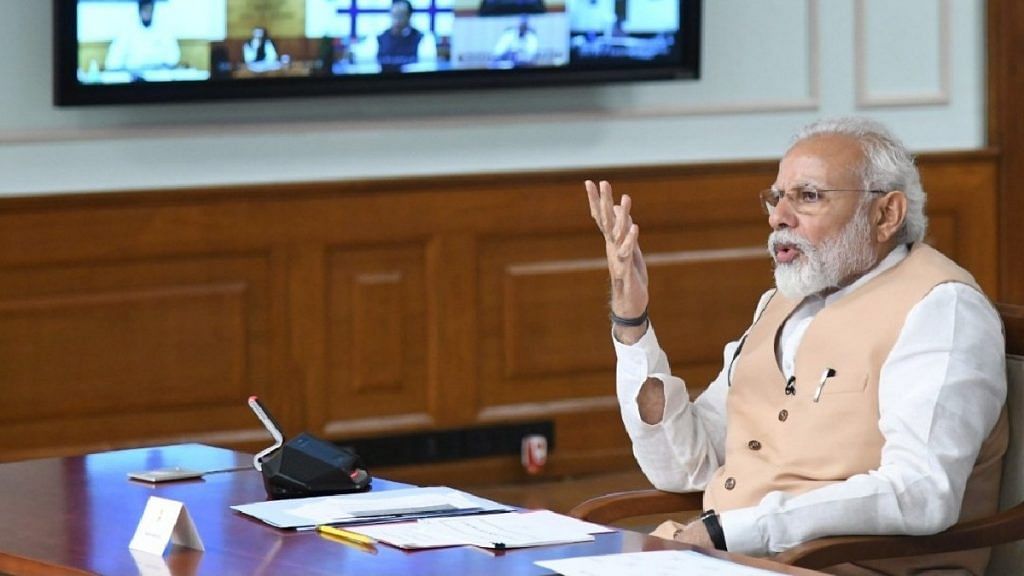Prime Minister Narendra Modi sure knows how to make lemonade when life hands him lemons. SAARC and NAM are two blocs that he had distanced himself from – one because of Pakistan-sponsored terror and the other because of its Cold War-Nehru legacy. But with the coronavirus pandemic, Modi rushed to turn these into a platform for diplomatic muscle.
“Even as the world fights Covid-19, some people are busy spreading other deadly viruses, such as terrorism, such as fake news, and doctored videos to divide communities and countries,” Modi said at a virtual summit of the Non-Aligned Movement (NAM).
While the coronavirus pandemic left governments and global leaders scratching their heads, Modi launched a major diplomatic blitzkrieg. First with SAARC, then with NAM.
Also read: Covid offers India-Pakistan a chance to fight common enemy, bury hostility over Kashmir
Coming around on SAARC
Being fully cognisant of the fact that the pandemic and its impact will be unprecedented and require a comprehensive policy of best practices, PM Modi startled many, including his own party leaders, when he announced a virtual South Asian Association for Regional Cooperation (SAARC) Summit of sorts that culminated in the creation of a Covid-19 Emergency Fund with India pledging a $10-million contribution.
Despite criticism from his supporters, Modi, whose Bharatiya Janata Party has repeatedly asserted that “terror and talks cannot go together”, was willing to discuss the pandemic and ways to mitigate it even with his arch rival Imran Khan, the prime minister of Pakistan.
This shook the neighbouring country out of its wits. The ball was suddenly now in Pakistan’s court. Not one to easily relent, even during a public health emergency, Pakistan marked its attendance at the virtual summit, though it wasn’t through PM Imran Khan but his special advisor on health Zafar Mirza, who couldn’t help raise the Kashmir issue.
That helped PM Modi take the spotlight and garner diplomatic praises from the US, Russia and others.
SAARC has remained fragmented ever since its creation in 1985. However, while refusing to attend the summit in Islamabad in 2016 over the Uri attacks, India was also able to convince members such as Bangladesh, Afghanistan and Bhutan not to participate and “diplomatically isolate” Pakistan.
Team Modi’s intransigence towards SAARC was clearly spelt out by then newly appointed external affairs minister S. Jaishankar, who had said at an event in June 2019 that SAARC has “certain problems”, which is why Modi chose to invite BIMSTEC leaders instead to attend his second oath-taking ceremony.
Modi’s recent overtures also lie in the fact that, of late, India had been pushed into a corner for not letting SAARC function normally. Member nations such as Nepal, Sri Lanka and Bangladesh, who had earlier tacitly supported New Delhi’s prodding to give the 2016 SAARC Summit a miss, eventually got exasperated and started pressing Modi to bury the hatchet and come around.
Also read: Modi slams Pakistan at NAM meet, says some countries busy spreading ‘other deadly viruses’
With NAM, returning to foreign policy basics
The Non-Aligned Movement (or NAM), a Cold War-era grouping and India’s first prime minister Jawaharlal Nehru’s brainchild, held its first conference in 1961 with Indonesia’s President Sukarno, Egypt’s President Gamal Abdel Nasser, Ghana’s President Kwame Nkrumah and Yugoslavia’s President Josip Broz Tito being in attendance at Belgrade. The term ‘Non-Aligned Movement’ was coined by veteran Indian diplomat V.K. Krishna Menon at the United Nations in 1953, which was later promoted by Nehru.
NAM did not feature even remotely in Modi’s foreign policy since he first came to power in 2014, with the PM vehemently refusing to attend the two summits held during his tenure — in 2016 and 2019. Not only that, Modi’s India openly aligned with the US on strategic as well as security initiatives such as the Indo-Pacific and Quadrilateral Dialogue or Quad, in a departure from NAM’s founding principle of not aligning with any superpower.
The attitude of the Modi government towards NAM got crystallised when former foreign secretary Vijay Gokhale said at the 2019 Raisina Dialogue that “India has moved on from its non-aligned past. India is today an aligned state — but based on issues.”
However, with the pandemic raging on and coronavirus cases increasing in India, PM Modi perhaps sensed a great opportunity to use a forum he had so far ignored and thus decided to attend a virtual Summit of NAM Contact Group and even gave suggestions on how the member countries can come together to fight the pandemic.
As discussions about a post-Covid world takes centre stage, the South Block must have learnt a hard lesson: in times of crisis, one has to go back to the basics of foreign policy that seeks friendship and cooperation while also adapts and adjusts in a changing world.
Views are personal.
